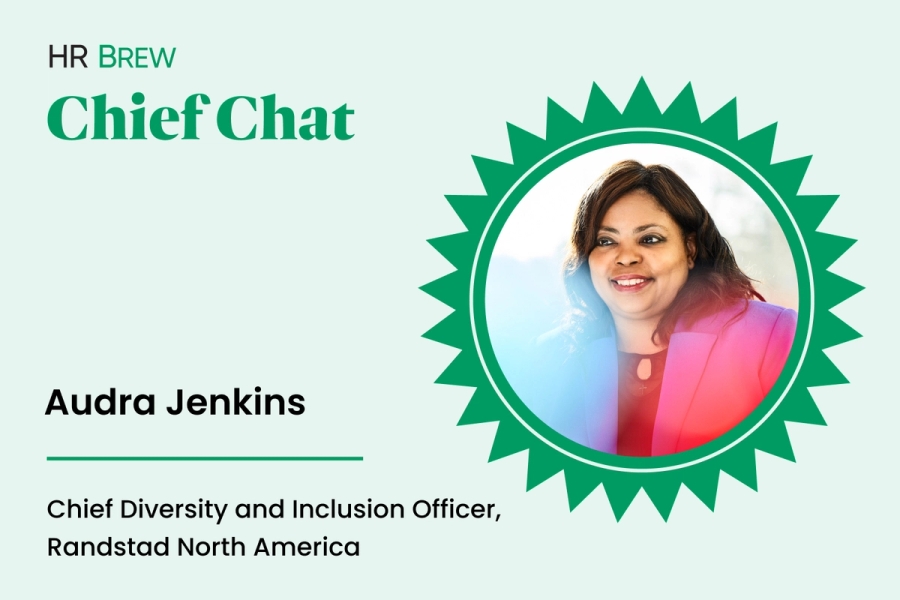Audra Jenkins is the chief diversity and inclusion officer at Randstad North America, the largest staffing firm in the country. Randstad recently published a diversity report, showing the company beat national workplace diversity statistics with 60% female leadership and 34% employees of color, compared to the national BLS benchmark of 22.5%.
We spoke with Jenkins in March about this achievement, and, in particular, how Randstad didn’t reach these milestones overnight. Jenkins shared the role passion played in sparking Radstad’s diversity initiatives, the organizational effort that sustains them, and the enduring importance of sitting down and answering employees’ questions about DE&I.
This interview has been lightly edited and condensed for clarity.
This diversity report is really impressive. One of the things that immediately stood out to me was that y’all have been investing in diversity initiatives since 2014—well before DE&I was trendy. How did HR make the business case to launch Hire Hope (a DE&I-meets-CSR program designed to upskill women experiencing homelessness)? Really, it was just a group of passionate people who were volunteering in the Atlanta market and noticed that human trafficking was a real thing and was happening in everyday neighborhoods. So that’s how we started Hire Hope—it really was just a passionate group of people that came together as employees and presented it to our HR department, as well as our CEO, to get support for the program.
There’s that word: passion. But of course, passion might start something. How do you keep a program going? When I took over the program [in 2017], we became more structured, we got a business plan for our community partners, and we got some funding approved from our CEO. That’s how you keep it going—you have to have funding. You can’t rely on passionate volunteerism to make an impact.
And so the funding of the program, we said, “Hey, we’re helping these women, we need to also give them some training that will give them actual jobs.”…And so hiring them on as apprentices and paying them really became the game changer for us. That’s how we were able to demonstrate to our clients our mission, vision, and values around getting work for everybody. So that’s how we were able to sustain it.
Your diversity report shows that, by and large, many of your programs designed to recruit diverse talent have been very successful, but I’ve heard from some HR teams that they’re very frustrated. They spend a lot of money on DE&I and can’t seem to crack the code. What’s your advice to them? You could throw all the money in the world at [attracting talent],…but if you’re failing to really address the underlying root causes of why people leave—if they’re not feeling valued, appreciated, promoted, seen, visible, and heard, respected—then they’re not going to stay. So if you’re putting money into bringing [people] in—anybody can throw money and bring in diverse talent—you can bring them in with a carrot at the front door, but they’re going to go out the back door if they come in and find out you’ve got [a] toxic-waste dump inside your organization’s four walls.
Quick-to-read HR news & insights
From recruiting and retention to company culture and the latest in HR tech, HR Brew delivers up-to-date industry news and tips to help HR pros stay nimble in today’s fast-changing business environment.
So you really have to be intentional about looking at what’s causing people [distress]. Are you dealing with microaggressions? Is there a good old boys clique? Do women have a glass ceiling and a glass floor? Are you developing people? What's the holistic picture? You can’t just look at bringing them in the door. That’s one leg of a three-legged stool. It’s also culture, it’s also compensation. Are you paying people right in the market? This is a tough market right now. If you want people to stay, pay them what they are worth, and not what you think they’re worth. So I think that's one thing. I think the other thing is looking at benefits.
So thinking about the culture component, what’s one thing companies can do to improve their cultures? What makes people feel, as you said earlier, seen, valued, and heard? I think the first, the biggest thing is to create safe spaces. Psychological safety is real. If you can’t be truthful about what’s happening in your culture, you can’t change your culture. I think it starts with that, like, go and have these conversations.
You’re only one person! How do you promote that culture with managers OR with HR generalists? What type of training is necessary to provide workers so they can make safe spaces for employees? We actually have leadership calls. For example, after the George Floyd killing, a lot of people did not know what to do. And I met with the CEO [of Randstad] and the CEO’s direct reports. I said, “Ask me any question. Nothing is off limits, send it to your admin if you’d like.” I answered every single question, no matter if it was inflammatory or not. The second strategy I used is I went to every direct report to the CEO and I said, “I’m happy to do a town hall with your leaders and do the same thing. Ask me any questions.” Because if you’re armed with some resources, if you’re armed with facts and figures, and empathy, you can answer. Culture is not one person’s responsibility. It’s every person in your organization who lives and breathes. And so that is what they need to know.—SV
Do you work in HR or have information about your HR department we should know? Email [email protected] or DM @SusannaVogel1 on Twitter. For completely confidential conversations, ask Susanna for her number on Signal.
